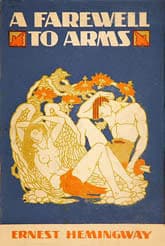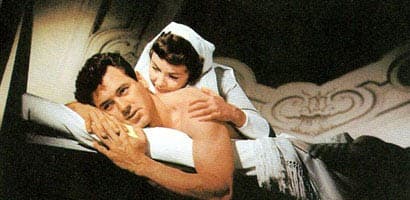A Farewell to Arms
Critique • Quotes • At the movies
 First edition, 1929
First edition, 1929First publication
1929
Literature form
Novel
Genres
Literary
Writing language
English
Author's country
United States
Length
Approx. 101,000 words

Soldier Frederick Henry (Rock Hudson) is treated by nurse Catherine Barkley (Jennifer Jones).
Epic farewell
A Farewell to Arms (1957): Film, 152 minnutes; director Charles Vidor; writers Ben Hecht, Laurence Stallings; featuring Rock Hudson, Jennifer Jones, Vittorio de Sica
The 1957 remake of A Farewell to Arms seems like a good idea. Update the film technically with colour and improved sound. Give it more time, two and a half hours, to develop the characters and include more of Ernest Hemingway's novel. Play it more sophisticatedly for a more knowing audience. And make the war scenes more horrible.
In short, go for another Gone with the Wind—which is what producer David O. Selznik is reputed to have thought. Starting with the tagline displayed over the opening under the title: "A romantic tragedy of wartime."
But this Farewell to Arms, directed by the workmanlike Charles Vidor, raises the romance to an even giddier height, again swamping with sentiment the harder side of Hemingway's story. The actors, with Rock Hudson and Jennifer Jones in the lead, are up to the romantic task—despite Hudson being too 1950s-style good looking and despite Selznik's wife Jones really being too old (in her upper thirties) for the role. Famed Italian actor Vittorio De Sica takes the Rinaldi role as credibly as you would expect–and earns an Oscar nomination for it.
We get more of the original story, with wonderfully awful depictions of the Italian retreat, the horrors of the arrest and sentencing to death of Henry and Rinaldi, and the excitement of the lovers' escape to Switzerland.
Moreover, the tragic conclusion is played out in excruciating detail.
Trailer for 1957's remake of A Farewell to Arms.
Unfortunately now though, the film drags, especially in the endless love scenes and the ain't-we-got-fun montages of the lovers' romps in Italy and Switzerland between the serious scenes.
Oddly, neither this film version nor its forerunner were based directly on Hemingway's novel but rather on a stage play adapted from the book by Laurence Stallings. Oddly because the films are so different. The first one reflects Hemingway's style better, while this one captures more of the story.
Neither comes anywhere near what Hemingway created. But why bitch about it? Perhaps filming Hemingway's story exactly as written would have resulted in a drearier film that would interest no one, except a few Hemingway purists like myself.
I should probably be thankful I've never seen the 1966 television mini-series of Farewell to Arms starring George Hamilton and Venessa Redgrave.
A 1951 movie, Force of Arms, directed by Michael Curtiz an featuring William Holden as an American soldier in Italy during the Second World War, is supposed to be an uncredited update of A Farewell to Arms. Didn't see that one either. Will try not to.
— Eric
Critique • Quotes • At the movies
1932, 1957

